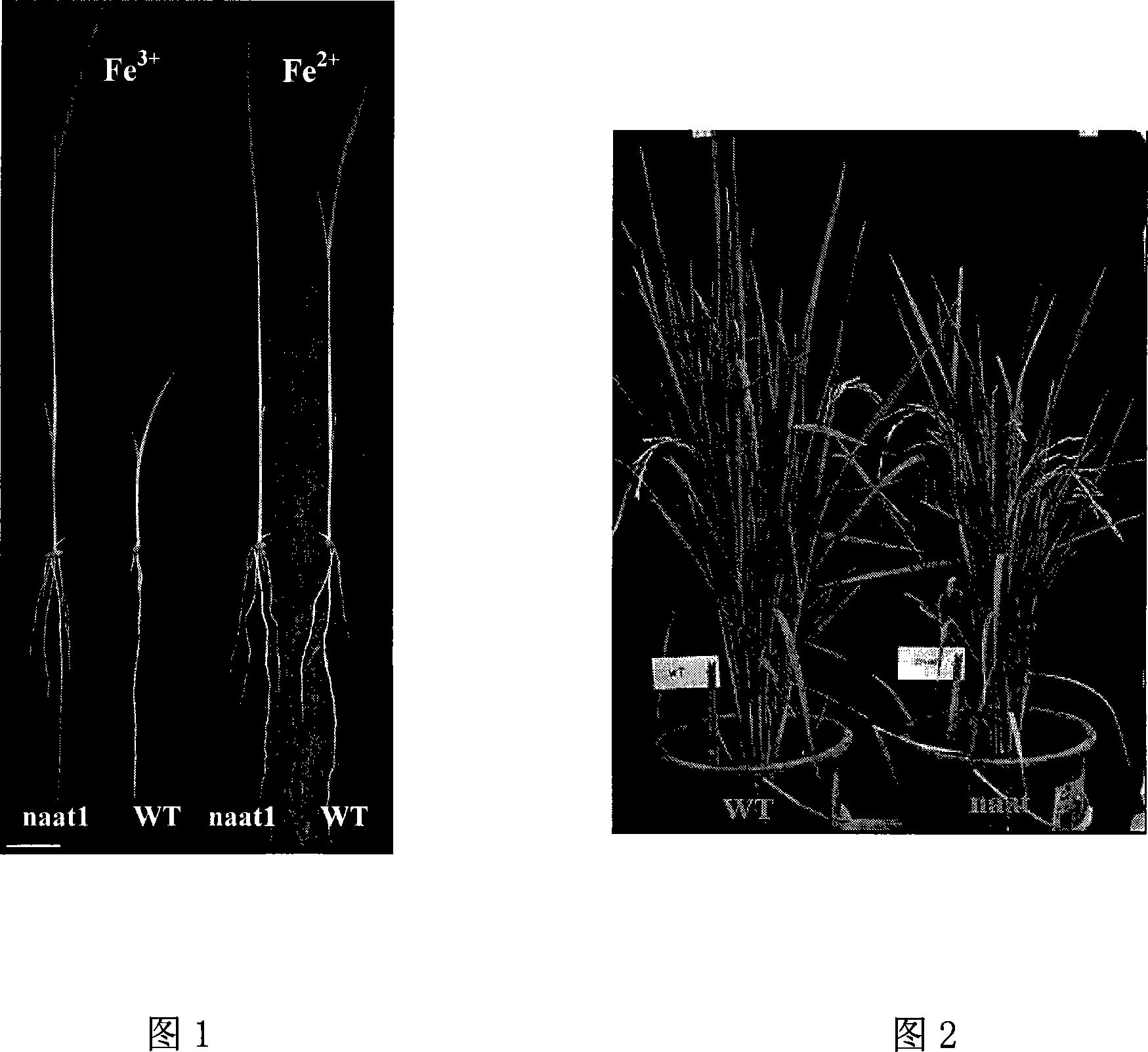Mutant gene Osnaat1-1 of rice rich in iron and zinc
A rice and genetic technology, applied in the fields of application, genetic engineering, plant genetic improvement, etc., can solve the problems of lack of rice germplasm resources, iron content and distribution can not meet the needs of nutritional breeding, etc., to improve the absorption and accumulation capacity, express enhanced effect
- Summary
- Abstract
- Description
- Claims
- Application Information
AI Technical Summary
Problems solved by technology
Method used
Image
Examples
Embodiment 1
[0046] Embodiment 1, the screening of mutant:
[0047] Seeds in the rice mutant (Nipponbare) bank were soaked at 37°C to accelerate germination and sowed into the culture solution (standard formula of the International Rice Institute, Yoshida et al. 1976). The nutrient solution contained 40ppm N(NH4NO3), 10ppm P(NaH2PO4·H2O), 40ppm K(K2SO'), 40ppm Ca(CaCl2@2H2o), 40ppm Mg(MgSO·7H2O) and trace elements such as Mn, Mo, B, Zn, Cu and Fe. The final concentration of Fe in the solution is 36 μM, supplied as citrate-Fe 3+ . Float a gauze on the nutrient solution, put the rice seeds on the gauze, grow for 10 days under the conditions of 80% relative humidity, 30° C. during the day and 22° C. at night, and perform mutant screening. A mutant with severe growth retardation, yellowing of above-ground part, shortened adventitious root and lateral root, and lateral root growth extending down to the part near the root tip was screened. The mutants withered and died after growing in this m...
Embodiment 2
[0048] Example 2, Responses of mutant naat1 to different iron forms:
[0049] Mutants cannot grow on Citrate-Fe containing 3+ or FeCl 3 etc Fe 3+ In the environment where the form exists, but when we culture him in the environment containing EDTA-Fe 2+ or FeSO 4 etc Fe 2+ It can grow normally in the form of nutrient solution (Figure 1). And in Fe 2+ The seedlings cultivated in the nutrient solution can grow and develop normally and bear fruit (Fig. 2) like the wild type under the condition of flooding soil culture.
Embodiment 3
[0050] Embodiment 3, the gene cloning of mutant:
[0051] Mutant naat1 crossed with indica rice Kasalath to obtain F1 generation hybrids, F 1 Planting Harvested F 2 Substitute seeds, direct seeding to rice basic nutrient solution (Citrate-Fe 3+ ), cultured for 10 days to observe the segregation, the results showed that the segregation ratio of the wild phenotype and the mutant phenotype conformed to the segregation rule of 3:1, which proved that the mutation was a recessive mutation controlled by a single gene. In F2, 30 individuals with mutant phenotypes were selected to extract DNA, and the SSR analysis method was used for preliminary positioning. According to the SSR polymorphic markers provided by the Gramene (http: / / www.gramene.org / ) website, each chromosome Select reasonably distributed SSR markers (about 5), first in a small amount of F 2 Coarse mapping was performed within the population (about 30), and the mutant gene was located on the short arm of the second chro...
PUM
 Login to View More
Login to View More Abstract
Description
Claims
Application Information
 Login to View More
Login to View More - R&D
- Intellectual Property
- Life Sciences
- Materials
- Tech Scout
- Unparalleled Data Quality
- Higher Quality Content
- 60% Fewer Hallucinations
Browse by: Latest US Patents, China's latest patents, Technical Efficacy Thesaurus, Application Domain, Technology Topic, Popular Technical Reports.
© 2025 PatSnap. All rights reserved.Legal|Privacy policy|Modern Slavery Act Transparency Statement|Sitemap|About US| Contact US: help@patsnap.com

